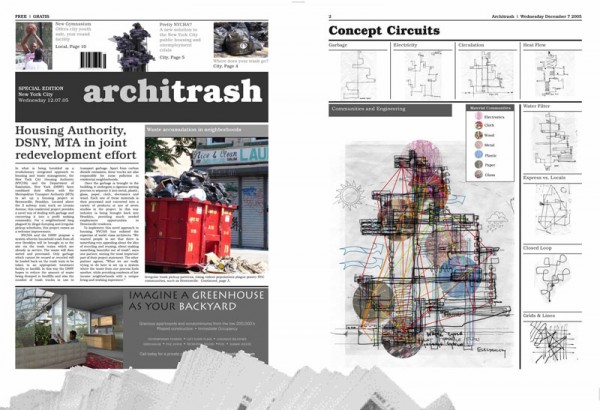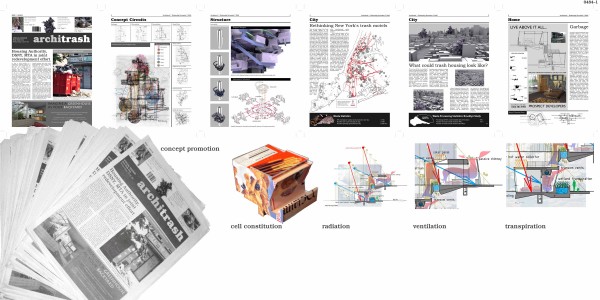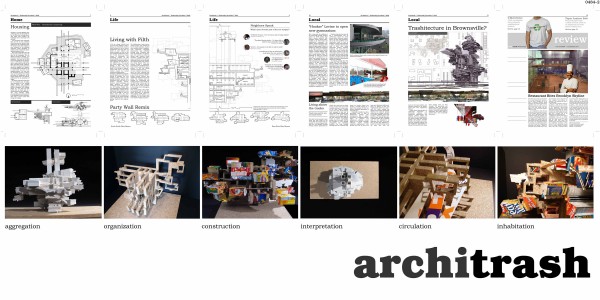Green Skyscrapers
In the next few days we will showcase 25 innovative proposals for green skyscrapers. These projects were submitted for the Annual Skyscraper Competition from 2006 to 2009.
Project 6 of 25
Chris Kroner, Swati Salgaocar
United States
Scraping the sky
The next skyscraper will not only be built through smart design, but also through effectively advertising itself to the public. Concept marketing would need to help sway public misconceptions about building and programming tall buildings. Looking back to the Chicago Tribune tower competition, skyscrapers and newspapers already have a linked history. This project looks to be marketed as a newspaper to the public before breaking ground to sell the idea to the masses.
Recall the dense masses of medieval and renaissance cities, and the innovation of skyscrapers designs after the New York Zoning law of 1916 as generators for the texture of the tower form. The building is started with large vertical elevators as the main core of the building. This skyscraper is then an aggregation of clustered apartments and programs, spiraling around cruciform steel structure plates, which are attached to the elevators. Aggregated cells of housing wrap program centers, making building clusters. These clusters can be rearranged offering tall or low buildings, and they can be rotated and placed for climatic tuning. The premise behind such a building is based upon problems of urban waste. The clusters sort, clean, reuse and disperse all types of recyclable waste, which becomes retooled for more construction within the skyscraper or becomes products to be sold for revenue.
Rethinking trash motels
Waste management in cities is a perpetual problem. In New York City for example, with the final closing of the Fresh Kills landfill, officials at the Department of Sanitation, New York were confounded with the problem of disposing thousands of tons of trash a day with seemingly no place to dump it. So they responded with a stopgap measure – cart it off to other states, which led to large expenses to the DSNY. Additionally, they had to deal with the problem of the temporary storage of this waste until it could be put on the next train or barge out of New York. The Department set up large number of waste transfer stations to house this garbage, a total of 125 throughout New York, often in low-income neighborhoods. These waste transfer stations can be thought of as “trash motels” or “temporary landfills” because in essence they are not equipped to treat or process garbage, but rather they house it till it can be moved out to either a landfill or a waste processing facility.
By mating typologies, a vertical waste processing facility and urban housing would alleviate both problems while minimizing their footprint. The basis of this new building type is that residents can extract the maximum amount of reusable and recyclable material from household garbage and convert it into useful items in studio workspaces that are integrated into their neighborhoods. This greatly reduces the amount of trash that will have to be moved out of the building while simultaneously giving residents job opportunities in these facilities. By sorting and processing the trash in a facility that is adequately equipped to deal with the byproducts of decomposing garbage, there is a lower risk of contamination of ground water and production of noxious gases.
Living above the tracks
This project provides a way of dealing with garbage and converting it into a commodity. The building is targeted for neighborhoods plagued by illegal dumping and irregular trash pickup cycles. By using mass transit, we propose a system wherein household trash from the city will be brought into the site via the trash trains that are already in service. The waste will then be sorted and processed. Only garbage that cannot be reused or recycled will be loaded back onto trash trains to be taken to an appropriate treatment facility. The use of the trains would help reduce the number of trash trucks that transport garbage. Apart from carbon dioxide emissions, these trucks are also responsible for noise pollution in residential neighborhoods.
Once the garbage is brought to the building, it undergoes a rigorous sorting process to separate it into metal, plastic, glass, paper, cloth, electronics and wood. Each one of these materials is then processed and converted into a variety of products at one of seven studios in the building. In this way, industry is being brought back to the city, providing much needed employment opportunities to underprivileged neighborhoods.
We want to setup a system where the waste from one process fuels another, while providing residents of low-income neighborhoods with a unique living experience. By recycling garbage on site and using a city’s subway system to remove unprocessed garbage from the project, garbage management could become something desirable. The large building hovering above subway train tracks would be a veritable marker for a building that occupies the fine line between traditional perceptions of clean and dirty.
By using the trash trains that are already in service, to transport the garbage would be a clean, efficient alternative to garbage trucks. Building residents can find employment opportunities an elevator ride away from their home while helping clean up their community. The greenhouse and mushroom farm use processed kitchen waste to grow fresh organic produce. Instead of displacing local businesses, this project aims to provide better, more sustainable alternatives.
Living with Filth
The building has seven sorting centers for the seven types of recyclable materials, each attached to its own studio workspace. Each of these studios defines a neighborhood community comprising approximately sixty individual housing units. Residents of the building also have the benefit of a gymnasium with activities as varied as yoga, aerobics, cardio machines, a weight room and a sauna, in addition to two full size basketball courts and an Olympic size swimming pool with competition diving. Other key facilities include community greenhouses and a mushroom farm, both of which supply fresh organic produce to the fine dining restaurant attached to them.
To handle waste in a housing tower, more infrastructures would need be integrated into the building’s design. The skyscraper has its own incinerator, water filtration plant, biogas production facility and composter. Individual housing units are tied to programmatic areas by a spiral path that acts as a conduit for a wetland filtration system. Namely, the biogas production facility would get its raw material from the black water generated by the building sewage system. The resulting biogas is then fed through pipes to kitchen throughout the building. Biogas is a very clean fuel that burns with no smoke and is a suitable alternative to cooking gas. The water filtration facility processes both gray water produced in the building as well as collects rainwater. This water is then cycled back though the building.
What could trash housing look like?
This skyscraper could be propagated throughout a city by identifying several sites currently occupied by waste transfer stations and nearby elevated subway tracks for such building development. Several clusters of housing units attached to sorting and processing facilities compose the housing tower. Each studio neighborhood is a separate entity, two or more of which can be combined for each site, depending on the quantity of trash produced in the area serviced by it. The units are flexible enough to satisfy a variety of needs. There are studio, one-bedroom, two-bedroom, three-bedroom and four-bedroom apartment cells which can be constructed in any combination depending on the demand in a particular location. Each of these housing units incorporates products from the studios they are attached to, thus giving each neighborhood a material identity of its own. What is remarkable is the variety of products that come out of these studios. Entire walls made out of used plastic and glass bottles, beautiful furniture fashioned out of scrap wood, quilts made out of old clothing, glass sculptures, the list is endless.

















